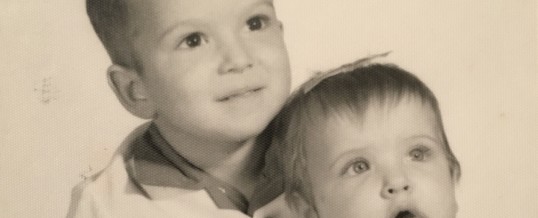
The sound of passing cars was constant. The small, rented, pier and beam house sat just a few dozen feet from the highway.
Across the street, a manufacturing plant provided jobs for the locals. They made clothing.
He would sometimes sit on the front porch with his legs dangling over the edge, barefoot and shirtless during the warm months, and watch them come and go. He was free to be outside and enjoy life until shift change at the end of the day, when he knew he’d be called back home.
His parents were like many of the day. The boy’s dad worked. His mom stayed home and ran the household, all while chasing after him and caring for his infant sister.
He was the first-born grandchild on either side of the family, so to say he was doted on and spoiled would be an understatement. His grandparents, aunts, and uncles, would visit often. They would take him for rides in the car. They gave him gifts.
His memories from this period would be sparse, but thankfully, they would remain. These would be the first Christmases he remembered.
The house seemed large, although to a child, most things do. The Christmas trees his dad brought home were harvested by hand and placed in a stand on a blanket in front of a window.
The decorations were simple. Many were homemade, but not the icicles. The icicles were likely bought at the Ben Franklin five and dime. The rest of the decorations were fragile glass ball ornaments that had been given to his family by relatives or craft projects made at home or at church.
The strands of colored lights were always a concern. Brought out of storage each year, if one bulb didn’t work, the entire strand would not light up. He would not recall a year when the lights had failed to shine.
His mother made sure that he understood that the meaning of Christmas wasn’t pretty trees or presents. The decorations made at church for the tree at home always came with an emphasized message of why the season was celebrated.
Colored construction paper loops, held together by Elmer’s Glue and made into chains, circled the tree from top to bottom. Popcorn was popped and strung together with a needle and long thread. The popcorn strands would also go from top to bottom, criss crossing the colored loops, giving the tree a look of synchronized spirality.
These projects would become family traditions and would bring he and his sister together to make the decorations each December. He would later treasure these memories more than any possession.
The rented pier and beam house was eventually left behind for his family’s first owned home. The red brick house on Beech Street had large windows in the front. It was there each Christmas in the living room that his father would set up the cedar in the stand on the blanket.
Now, old enough to do most things on their own, he and his sister would take turns working on the colored loop chains, and stringing the popcorn.
The family outgrew the Beech Street home. A new one near the local high school was built by his parents, and it was there that he, his father, mother, and sister, would celebrate their remaining Christmases under the same roof.
He moved away from the new house, married, and had two sons. Passing along to his children what he had learned, each Christmas would include family time for decorating the tree with craft items the boys had assembled at home or in church. But, the emphasis was placed on why the season was celebrated and not on the decorations or gifts.
His sons grew to become men, left home, and started their own families and lives.
He hoped that what he had been taught and passed down about Christmas and its true meaning would stay with his children, grandchildren, and their children, long after he was gone.
Years passed. He and his parents faced the first Christmas without his sister. He thought back to sitting on that front porch and watching the cars come and go at the manufacturing plant.
He said a prayer that everyone would embrace the true meaning of Christmas and accept the Son of God. While they were still free to enjoy life, and before they were called home.
©2017 John Moore
John’s new book, Write of Passage: A Southerner’s View of Then and Now is available on Amazon.
DEC
2017
